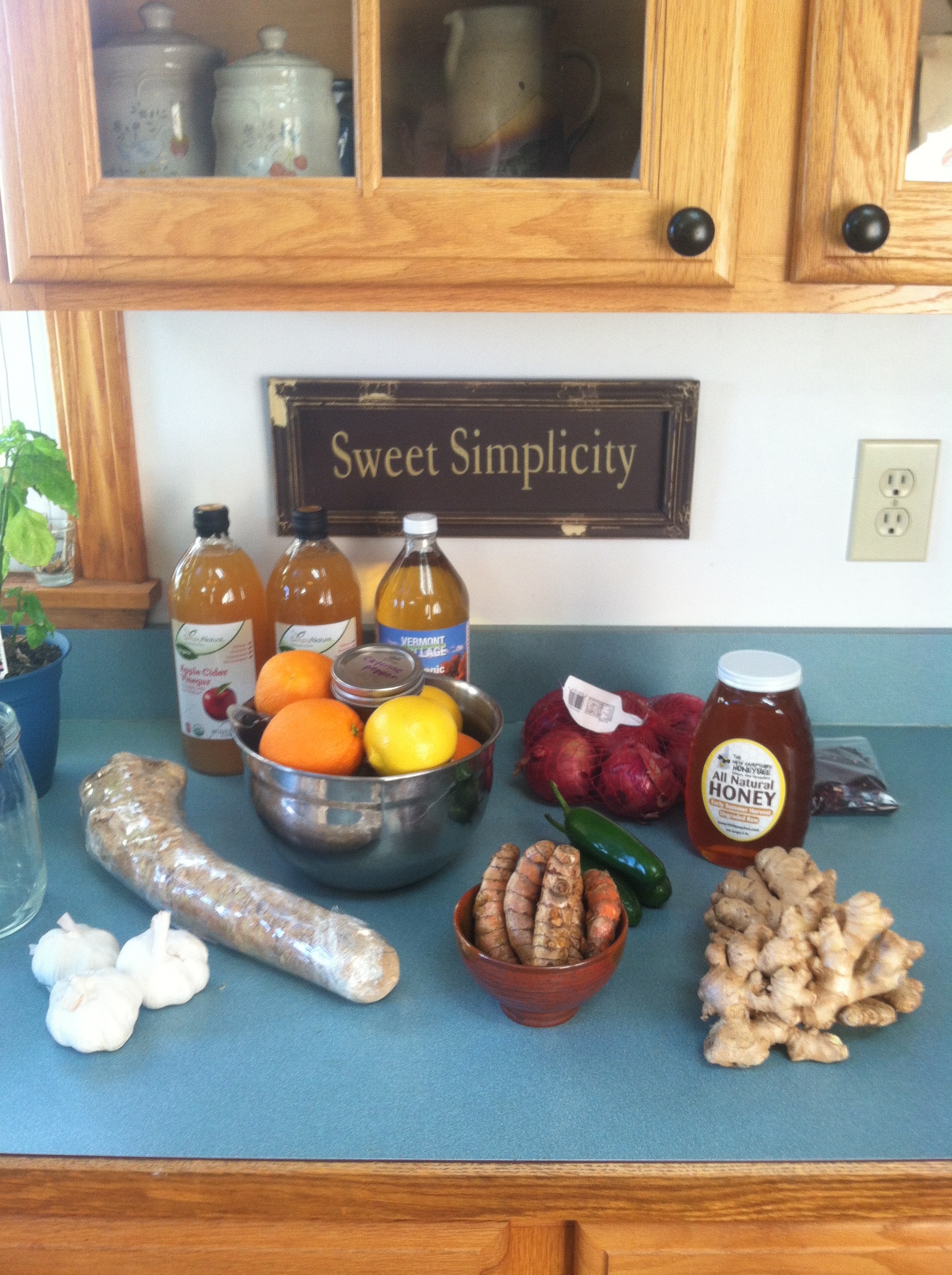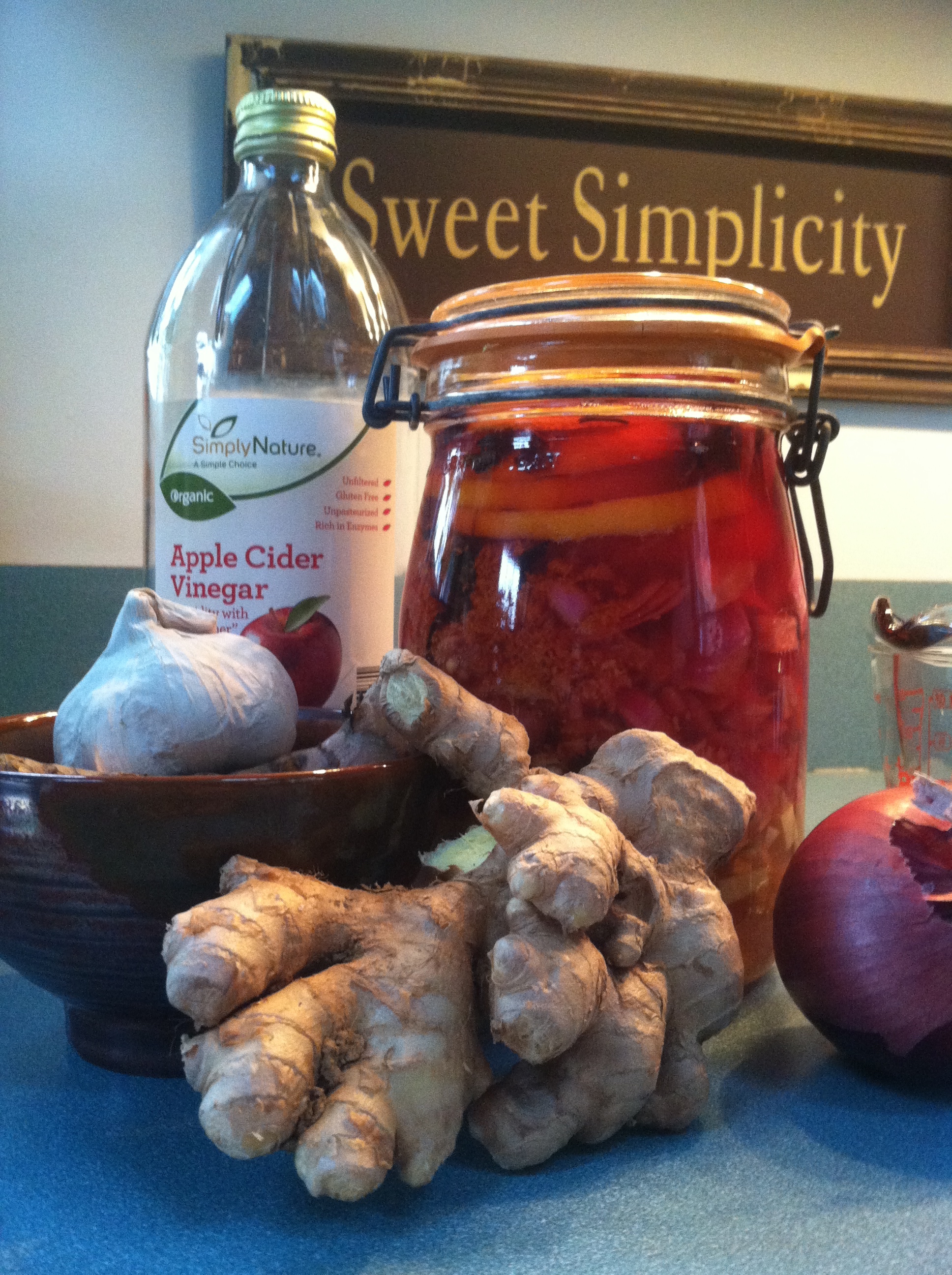Fire Cider: What, How & Why?
It’s getting brisk here in New Hampshire. The thermostat read nineteen-degrees this morning as I blasted a mallet through the frozen crust on Panda’s trough. Time to prep for constant cold. Insulate, layer, keep dry and stay warm: at Sweet Birch Homestead, this is my mantra and the things that can make or break my season.
Struggling through the winter makes it longer and harder to bear, whereas embracing the frigid season with full preparedness makes it not only more tolerable, but sometimes, genuinely enjoyable. That is until all the temperature fluxes and shared germs of the holidays arrive. In which case: fire cider to the rescue!
Last night I hosted my first class of Autumn here at The Magpie’s Apprentice. We were learning about and then making, some homemade fire cider. Fire cider is a staple in my home. Just ask my friends; they can testify to that since I am forever making them taste new recipes of this delicious, albeit spicy, blend of herbs and vinegar. I first began making this magical concoction four years ago when a grad school colleague turned me onto the pungent panacea.
I was in my fourth semester of graduate school when the onset of a sinus infection brought me to a groggy halt. My maxillary sinuses (those below the eyes) and frontal sinuses (above the eyes) felt so swollen it was as though my face had a pulse of its own. When menthol massages and eucalyptus steams did nothing to drain them, I was frustrated and downtrodden. I knew the next step was an OTC medication and the price (remember, grad school student here) and unpleasantness of pill-popping was not my preferred method of recovery. Preventing a full-blown sinus infection, however, was going to result in more severe approaches, not to mention the added cost of a copay for an actual diagnosis.
The Universe intervened when my colleague commented on my incessant forehead rubbing and inquired as to what was going on. Within minutes of discussing my symptoms, she not only recommended fire cider (what in the world is this magic?), but also invited me to make a fresh batch with her that week. Let me tell you, best recommendation, ever! Since that life-altering recipe was shared, I have passed it on to numerous sinus sufferers. I should note here, that it’s not just sinus pressure that gets kicked to the curb with fire cider; it’s common colds and even the flu, too.
So what is fire cider and how does it work? Let me give you a brief description followed by the recipe I have adapted to better suit my needs.
Fire cider is a tincture, for all intensive purposes, and a tincture as defined by the herbalist community. It takes marc (raw materials such as herbs and spices) and places it in a menstruum (the liquid solvent) where it is left to sit while the nutrients, vitamins, minerals and enzymes (essentially all the “stuff” that makes up a plant profile) are extracted by that same menstruum. Once the extended marc is removed from the menstruum through various straining methods, the remaining product is the tincture. Simple enough, right?
Fire cider is said to have developed back in the early 80’s in the kitchen of renowned herbalist, Rosemary Gladstar. The concoction combines reputable ingredients (from folklore and ancient records) with apple cider vinegar to create a fairly magical remedy geared towards improving digestion and boosting immunity. Here are the ingredients and the constituents for why it is they work:

- Onions: onions are a super food! They are packed with B vitamins, C vitamins, folic acid and sulfites. Onions can improve digestion, promote healing and boost metabolism. Their anti-inflammatory properties combined with their role as an expectorant, makes them a powerhouse for both preventing and treating cold symptoms.
- Hot Peppers: capsaicin is the heat in hot peppers. This spicy compound can aid digestion, improve circulation and reduce pain and inflammation, making it an excellent addition to our fire cider.
- Citrus Fruits: besides being high in vitamin C, which supports a healthy immunity, citrus fruits like lemons and oranges also contain anti-microbial and astringent properties and add a burst of flavor to our cider mix.
- Horseradish: if just grating horseradish can open up your sinuses, imagine what consuming this incredible root can do. This herb rushes to the sinus cavities and flushes out congestion. It also is a fantastic digestive aid and we should all know by now, that a healthy gut makes a healthy person!
- Ginger: ginger promotes circulation, decreases nausea and is anti-inflammatory, thus relieving pain and swelling. It is a warming herb and aids in boosting immunity.
- Garlic: garlic is also in the Allium family and thus shares similar traits to its larger cousin, the onion. This herb has been used for millennia for its antimicrobial and antibacterial properties. Taking garlic has been proven to drastically reduce cold symptoms and shorten the duration of said cold.
- Turmeric: known for its anti-inflammatory and antioxidant properties, turmeric is a great herb to promote health and wellness from the inside out.
- Hibiscus: the calyces of the hibiscus plant (Hibiscus sabdariffa) are loaded with Vitamin C. We use hibiscus in this recipe for the tangy taste and the immunity boosting properties, plus, I just can’t say no to its gorgeous hue!
- Apple cider vinegar: ACV is well known in the holistic health field. We use it in fire cider as the menstruum, that is, the liquid used to extract the nutritive and medicinal qualities of the marc (the raw materials in the tincture). ACV is palatable, astringent and locally available. Always choose the organic option when using ACV as a healing solvent.
- Honey: honey’s restorative properties have been revered since the days of Ancient Egypt. Used externally to heal abrasions and prevent infection, honey is packed with healthy enzymes used to ward of unwanted bacterium internally as well. I don’t know about a spoonful of sugar, but a spoonful of honey may be all the medicine you need!
You can add additional herbs or reduce the heat by omitting some of the above ingredients but I highly encourage you to stick to these four, regardless: horseradish, ginger, onions and garlic. Those are Nature’s antibiotics! The following recipe was adapted by me and one that I use at my homestead.

For a 32 oz. container
1 cup diced purple onion
2 jalapeno peppers, sliced.
1 lemon, sliced
1 orange, sliced
½ cup grated horseradish
¼ cup grated ginger root
4 cloves garlic, crushed or grated
2 tbsp. grated turmeric
½ tbsp. ground cayenne pepper
½ -1 tsp. dried hibiscus
Organic apple cider vinegar
3+ tbsp. reliably sourced honey
Instructions:
- Prepare all ingredients by dicing, slicing, squeezing and grating. This is where the health benefits begin! You’ll feel the horseradish and onions opening up your sinuses immediately. A well-ventilated location is recommended.
- Place all ingredients excluding honey in clean container.
- Cover completely with apple cider vinegar.
- Cover the concoction. If using a metal lid, place waxed paper between the lid and jar to prevent corrosion from the vinegar.
- Let sit for 4-6 weeks. I know waiting is the worst, but it’s worth it!
- Strain your fire cider. The remaining liquid is your soon-to-be final product.
- Add honey.
- Walla! You are done! Return your fire cider to its original container after a quick rinse or divvy it up into smaller containers. Use the pickled herbs and veggies mix on top of salads or as a stir-fry or dispose of as you wish!
Your fire cider will have a long and healthy shelf life as long as all the raw materials have been removed. Take a shot daily during cold and flu season or dilute in water or juice and enjoy!
